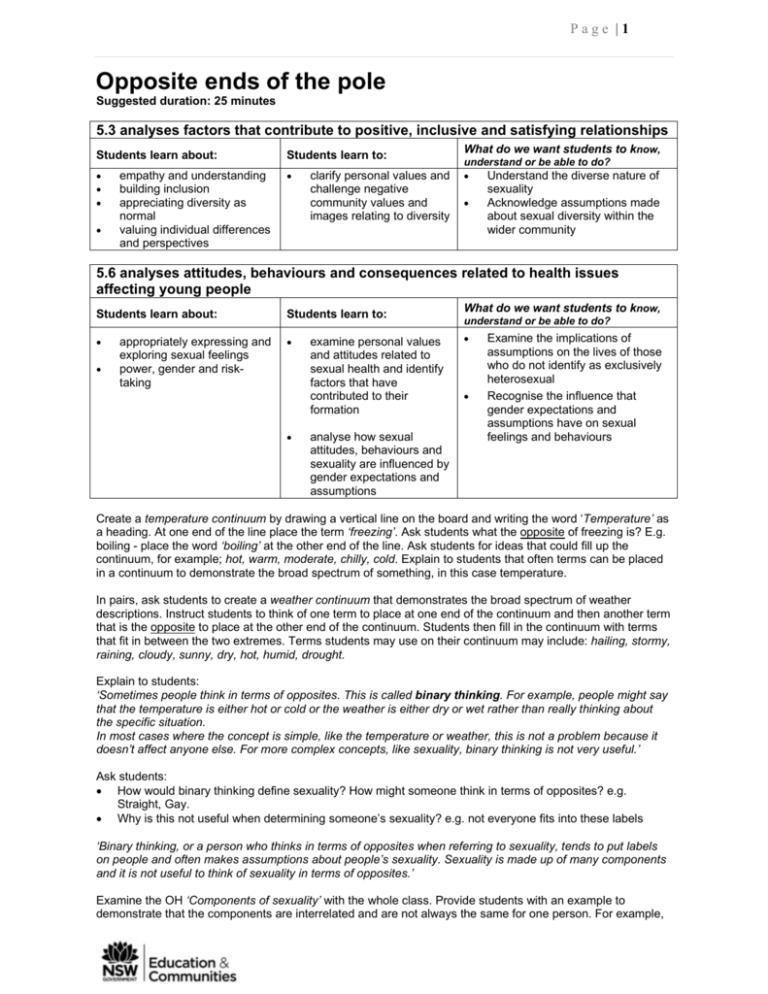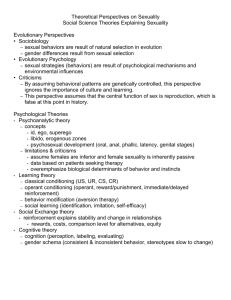
Page |1
Opposite ends of the pole
Suggested duration: 25 minutes
5.3 analyses factors that contribute to positive, inclusive and satisfying relationships
Students learn about:
Students learn to:
empathy and understanding
building inclusion
appreciating diversity as
normal
valuing individual differences
and perspectives
clarify personal values and
challenge negative
community values and
images relating to diversity
What do we want students to know,
understand or be able to do?
Understand the diverse nature of
sexuality
Acknowledge assumptions made
about sexual diversity within the
wider community
5.6 analyses attitudes, behaviours and consequences related to health issues
affecting young people
Students learn about:
Students learn to:
appropriately expressing and
exploring sexual feelings
power, gender and risktaking
examine personal values
and attitudes related to
sexual health and identify
factors that have
contributed to their
formation
analyse how sexual
attitudes, behaviours and
sexuality are influenced by
gender expectations and
assumptions
What do we want students to know,
understand or be able to do?
Examine the implications of
assumptions on the lives of those
who do not identify as exclusively
heterosexual
Recognise the influence that
gender expectations and
assumptions have on sexual
feelings and behaviours
Create a temperature continuum by drawing a vertical line on the board and writing the word ‘Temperature’ as
a heading. At one end of the line place the term ‘freezing’. Ask students what the opposite of freezing is? E.g.
boiling - place the word ‘boiling’ at the other end of the line. Ask students for ideas that could fill up the
continuum, for example; hot, warm, moderate, chilly, cold. Explain to students that often terms can be placed
in a continuum to demonstrate the broad spectrum of something, in this case temperature.
In pairs, ask students to create a weather continuum that demonstrates the broad spectrum of weather
descriptions. Instruct students to think of one term to place at one end of the continuum and then another term
that is the opposite to place at the other end of the continuum. Students then fill in the continuum with terms
that fit in between the two extremes. Terms students may use on their continuum may include: hailing, stormy,
raining, cloudy, sunny, dry, hot, humid, drought.
Explain to students:
‘Sometimes people think in terms of opposites. This is called binary thinking. For example, people might say
that the temperature is either hot or cold or the weather is either dry or wet rather than really thinking about
the specific situation.
In most cases where the concept is simple, like the temperature or weather, this is not a problem because it
doesn’t affect anyone else. For more complex concepts, like sexuality, binary thinking is not very useful.’
Ask students:
How would binary thinking define sexuality? How might someone think in terms of opposites? e.g.
Straight, Gay.
Why is this not useful when determining someone’s sexuality? e.g. not everyone fits into these labels
‘Binary thinking, or a person who thinks in terms of opposites when referring to sexuality, tends to put labels
on people and often makes assumptions about people’s sexuality. Sexuality is made up of many components
and it is not useful to think of sexuality in terms of opposites.’
Examine the OH ‘Components of sexuality’ with the whole class. Provide students with an example to
demonstrate that the components are interrelated and are not always the same for one person. For example,
Page |2
a person may be attracted to people of the same sex (orientation) but engage in sexual activity with people of
the opposite sex (behaviour).
In groups of three or four, ask students to examine the various character scenarios and complete the opposite
ends of the pole worksheet. Groups must indicate how traditional binary or opposite thinking would identify the
characters sexuality and determine each character’s sexuality by discussing their sexual orientation, sexual
behaviour, and sexual identity. Instruct students to use the terms same sex attracted and/or opposite sex
attracted to refer to differences in the character’s sexuality.
Teacher note: Groups may find it difficult to determine the character’s sexuality, don’t worry if students
become frustrated as they attempt to determine the character’s sexuality, this is part of the activity.
In their groups students answer the following questions and then discuss as a whole class:
Did the traditional binary thinking provide a clear indication of the character’s sexuality?
What made it difficult to determine the sexuality of each of the characters? e.g. components of sexuality
changed over time, sexual behaviour, orientation and identity were not the same.
Is defining a person’s sexuality as easy and clear as some people think? Why/Why not?
Debrief the activity with the following questions:
What assumptions are made when people use labels? e.g. labelling assumes that sexual behaviour,
orientation and identity are all the same and don’t change. Teacher note: it is important to recognise that a
person’s sexual behaviour, orientation, and/or identity may stay the same for their whole lives while for
others these components may change over time.
How do gender expectations contribute to assumptions made about sexuality? e.g. expectations such as,
males are expected to be attracted to females, and females are expected to be attracted to males
contributes to the assumption that if you don’t fit this expectation then you must be same sex attracted, or
there is an assumption that if you are male and you don’t behave in a masculine way you must be Gay.
How does labelling sexuality influence a person’s feelings or behaviour? e.g. labelling may make a person
feel negatively about themselves or that they are doing something wrong because they don’t fit into one of
the labels, labelling may cause a person to behave in a way that is not true to themselves because they
don’t want to be labelled, labelling may cause a person to hide their sexuality from others, or it may make
a person who does not fit into one of the labels feel like they are ‘abnormal’.
What are the implications for people who do not exclusively fit into the labels of binary thinking? e.g.
emotional distress, confusion, isolation, exclusion, low self worth, harassment, ridicule.
Why do you think sexuality is made up of so many components? e.g. sexuality is dynamic (constantly
changing), sexuality is very diverse, sexuality is different for different people and can vary at different
times in a person’s life.
Ask students to identify four things they have learnt from this activity about sexuality. Invite a few students to
share their ideas with the rest of the class.
Page |3
RESOURCE
Example continuums
Temperature Continuum
FREEZING
BOILING
COLD CHILLY
MODERATE
WARM
HOT
Weather Continuum
HAILING
HUMID
STORMY
RAINING
CLOUDY
SUNNY
Page |4
RESOURCE
Components of sexuality
Sexual
identity
Sexual
behaviour
Sexual
orientation
Sexual orientation – refers to a person’s basic attraction
to other people. This attraction may be to people of the
opposite sex (opposite sex attracted), people of the same
sex (same sex attracted) or people of both sexes (both
opposite and same sex attracted). Some people believe
their orientation is fixed while others have reported a
change in orientation at a particular stage in their lives.
Sexual behaviour – refers to what a person does sexually.
In some cases this behaviour matches a person’s sexual
orientation but in other cases it does not. For example, a
person may be involved in opposite sex attracted
behaviour but feel their orientation is same sex attracted
or vice versa.
Sexual identity – refers to how people see themselves
and how they present themselves to others. At times,
sexual identity can be different to a person’s sexual
orientation and sexual behaviour which can cause a high
level of personal stress.
Page |5
RESOURCE
Character scenarios
Thanh
Thanh is a university student who had a two year sexual relationship with her
female roommate. When the relationship broke up, she began dating a male
student. She has married him and enjoys their sex life.
Alex
After an adolescence that included dating and having sex with girls, Alex got a
job out in a remote country town. There he developed a close and loving
relationship which included sexual contact with another man. When he
transferred closer to his home, he began dating women again.
Paddydeh
Paddydeh is 30 years old and has only ever had sexual relationships with men.
In her last year of high school she was sexually attracted to one of her
girlfriends and for a few months fantasised about having sex with her. Since she
left high school she has never been attracted to another woman.
Phillip
Phillip says, by the time he was seven or eight years old, he knew he was
different to other boys. Since adolescence he has been involved in a series of
sexual relationships with men. Now middle aged, he has never had sex with a
woman, although many of his friends are women.
Zarita
Zarita was married for 16 years. During this time she had two sexual
relationships with men. She ended her marriage because she fell in love with
another man whom she has been with for the past three years. In this time she
has had 3 sexual encounters with other men.
Joseph
Joseph is married and has three children. His only experiences of sexual
intercourse have been with women. When he masturbates, he fantasises only
about men. Joseph talks negatively about men having sexual relationships with
other men although he himself is attracted to several of his male friends.
Page |6
RESOURCE
Opposite ends of the pole
Group worksheet
Character
How would binary
thinking label this
characters sexuality?
Sexual
orientation
Sexual
behaviour
Sexual
identity
Determine the
characters
sexuality
Thanh
Alex
Paddydeh
Phillip
Zarita
Joseph
Character
What factors influenced your decisions when determining the characters sexuality?
What things did you discuss as a group about the characters life?
Thanh
Alex
Paddydeh
Phillip
Zarita
Joseph
Discuss as a group:
Did the traditional binary thinking provide a clear indication of the characters sexuality?
_____________________________________________________________________________________
What made it difficult to determine the sexuality of each of the characters?
_____________________________________________________________________________________
Is defining a person’s sexuality as easy and clear as some people think? Why/Why not?
_____________________________________________________________________________________










